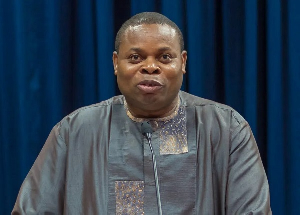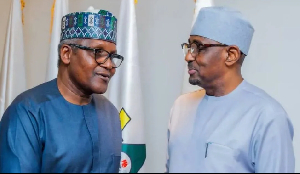Empirical evidence in the global arena reveals that education remains the most effective weapon to combat poverty and ensure national development. Education equips the individual with knowledge, competent skills, attitude and positive values that enable the person to function properly in a society. It is in this sense that conscious efforts continue to be made by national governments and other stakeholders – teachers, students, parents and NGOs to make education of the child a topmost priority in their daily affairs.
The record of achievements of the New Patriotic Party (NPP) under the able leadership of His Excellency, J.A. Kufuor in the educational sector cannot be underrated. Looking at the state of the economy in 2001 and the haste with which pragmatic programmes, policies, reforms, resources and infrastructure facilities were put in place to meet the educational needs and aspirations of the people, there is no shadow of doubt in my mind that the NPP government played a yeoman’s role in Ghana’s educational transformation. This was quite obvious in improved access, quality teaching and learning, teacher retention, infrastructure delivery as well as management efficiency at all levels of Ghana’s educational structure.
I was compelled to come out with this piece of information to clear the false impression being created by the NDC propagandists with regard to educational infrastructure delivery especially at the senior high school level. Many a times these ‘Yutong Bus passengers’ who are on the verge of being dumped into a ditch by their reckless ‘Yutong Bus’ driver – John Mills, throw dust into the public eye that the erstwhile NPP administration never built a single classroom block to meet the population demand of senior high schools. This write-up is therefore aimed at setting the records straight on how the NPP addressed a substantial part of the infrastructure and enrolment deficits at the educational front.
Readers will bear me out that the 1987 Education Reform introduced by the PNDC put the educational structure as follows: 6-3-3-4 i.e. six years of primary, three years of junior secondary and four years of university education. It is evident from the structure that Kindergarten education had no place in the PNDC’s educational system. It therefore took the ingenuity of President Kufuor and his administration to make a two year Kindergarten education a major component of the educational set up when the New Education Reform was introduced in 2007. Since policy makers failed to recognise the relevance Kindergarten education after independence, there were only 5,976 (five thousand, nine hundred and seventy-six) pre-schools (Kindergarten blocks) and an enrolment level of 649,677 (six hundred and forty-nine thousand, six hundred and seventy-seven) in Ghana by 2001. What was so worrisome was that there was no specific syllabus and the few unqualified teachers had to depend on primary one syllabus and textbooks for teaching and learning at this level. Anybody who has a little knowledge about child development and psychology could clearly discern that the Ghanaian was at educational risk right from his/her developmental age.
It was thus welcome news for the Ghanaian child when the NPP government decisively made Kindergarten education compulsory in 2007/2008 academic year. What was left was the provision of the needed infrastructure to meet the increasing demand. But this challenge did not deter an administration that was so focused on securing the future of its citizens. The NPP government built 5,164 (five thousand, one hundred and sixty-four) pre-schools across the length and breadth of the country between 2001 and 2009 and this brought the total number of pre-schools in Ghana to 11,140 (eleven thousand, one hundred and forty). It is worthy to note that the population of the Kindergarten pupils doubled as additional 608,323 (six hundred and eight thousand, three hundred and twenty three) pupils for the first time tasted formal educated at the age of four. In effect, 1,258,000 (one million, two hundred and fifty-eight thousand) pupils were in school as at the time of the NPP leaving political office in 2009. This significant leap in enrolment levels could be attributed to good programmes and interventions such as “My First Day at School”, capitation grant, school feeding etc - these would be discussed fully in part 2 of this article.
Another significant success was chalked at the primary school level by the NPP. With a total number of 11,919 (eleven thousand, nine hundred and nineteen) primary school blocks and a student population of 2,477,000 (two million, four hundred and seventy-seven), the NPP government constructed 1,331 (thousand three hundred and thirty-one) primary school blocks to bring the total number of public primary schools to 13,247 (thirteen thousand, two hundred and forty-seven). Consequently, 1,145,000 (one million, one hundred and forty-five) pupils were enrolled over the period thus bringing the total population of all public primary schools in Ghana to 3,622,000 (three million, six hundred and twenty-two) by 2009.
To raise the reputation of our basic and second cycle institutions, the 2007 Education Reform replaced junior and senior secondary schools (JSS and SSS) with Junior High and Senior High Schools (JHS and SHS) respectively. By the year 2001, Ghana could only boast of 6,133 (six thousand, one hundred and thirty-three) public junior high schools with a total population of 804,419 (eight hundred and four thousand, four hundred and nineteen). By the year 2009, an additional 1,134 (one thousand, one hundred and thirty four) schools had been added by the NPP government. This brought the total number of junior high schools in Ghana to 7,267 (seven thousand, two hundred and sixty seven). Besides, the population also saw an addition of 419,581 (four hundred and nineteen thousand, five hundred and eighty-one) pupils bringing the total population of JHS to 1,224,000 (one million, two hundred and twenty-four) by the year 2009.
At the senior high school level where so much controversy had generated, only 474 (four hundred seventy-four) public second cycle institutions with a student population of 204,000 (two hundred and four thousand) existed from independence till the NPP took over in 2001. However, with the help of the Ghana Education Trust Fund (GETfund), the NPP government was able to build 21 (twenty-one) new senior high schools to beef up the number to 495 (four hundred and ninety-five). This excludes a 102 (hundred and two) private senior high schools built over the period. In addition to the 21 new SHSs, 56 (fifty-six) existing senior high schools were chosen as ‘model schools’ to be developed into the status of well-equipped ones like Opoku Ware, Achimota and Mfantsipim schools and plans were far-advanced to establish a model school in all the 170 districts in the country. For instance, Kumasi Anglican Senior High School (KASS) and Effiduasi Senior High (EFFISCO) saw a facelift in all aspects of the school – teacher accommodation, new dormitories, new classroom blocks etc. The aim for the establishment of the model school was to optimize the utilization of the scarce resources - land and teacher population in those schools. In view of this pragmatic policy, an additional 250,681 (two hundred and fifty thousand, six hundred and eighty-one) students were enrolled by 2009 to bring the student population at the SHS level to 454,681 (four hundred and fifty-four thousand, six hundred and eighty-one).
At the tertiary level, the NPP established two polytechnics at Wa and Bolgatanga to bring the total number of polytechnics in the country to ten (10). A greater part of the infrastructure deficit at all the polytechnics was addressed and this helped the polytechnic authorities to enrol 10,225 students between 2001 and 2009. In effect, the polytechnic student population which stood at 18,470 in 2001 increased to 28,695 representing an increase of 55% whilst most of them were given the technical assistance to award bachelor degrees.
Teacher Training Education was not left out as far as infrastructure delivery under the NPP was concerned. All the country’s 38 (thirty-eight) teacher training colleges saw a major infrastructure revolution during the time of NPP administration. Apart from the buses released to these institutions, all the colleges were also upgraded to the tertiary status (Diploma Awarding Institutions) by the NPP administration.
It is the wish of every Ghanaian child to climb to the highest level of the educational ladder, hence their quest to acquire university education. Fortunately or unfortunately, Ghana over the years could only boast of 3 (three) traditional public universities – The University of Ghana (UG), Legon, Kwame Nkrumah University of Science and Technology (KNUST), Kumasi and the University of Cape Coast (UCC), Cape Coast until the University for Development Studies (UDS), Tamale was established in 1992 by the Rawlings-led NDC administration. One major record that needs to be set straight for the benefit of NDC fanatics in particular and Ghanaians as a whole is the establishment of KNUST. The CPP elements in the NDC are trying hard to make it appear that KNUST was founded by Dr. Kwame Nkrumah. After naming almost all national monuments including a Ghanaian currency note after the first president, these people are so desperate to change history to satisfy their whims and caprices. But whether they would succeed or not, I leave it for the good judgement of all Ghanaians. Known as Kumasi College of Technology, KNUST was founded on 22nd January, 1952 and during this time Kwame Nkrumah was even wallowing in prison. Indeed, through an Act of Parliament in 1961, KNUST became a full-fledged university on 20th November, 1961. I have no qualms as regards the credit being giving to Dr. Nkrumah for the role he played in making the university what it is today. However, if Nkrumah who had over £200m at his disposal with a population of only 6.5m was able to build ‘two’ universities – University of Cape and KNUST, then J.A. Kufuor who started his administration on HIPC and with 18.4m population should be equally commended for building two of the country’s universities – the University of Education (UE), Winneba and the University of Mines and Technology (UMAT), Tarkwa. This is because these two new public universities which were previously affiliated to the University of Cape Coast and KNUST respectively were granted full autonomy in 2001 by the Kufuor administration. What is good for the goose, they say is equally good for the gander.
Fellow Ghanaians, is it not surprising that by 2001 the enrolment capacity of all the public universities stood at 40,670 (forty thousand, six hundred and seventy), an average of 6,300 per institution? How prepared were we as a nation to tackle the myriad of problems confronting our beloved country with this slow-paced movement in education? It was against this background that the NPP administration put in measures that doubled the enrolment from 40,670 to 88,445 (eighty-eight thousand, four hundred and forty-five), a percentage increase of 117%. As a party that believes in the development of the private sector, a positive environment was created by the NPP government making it possible for the establishment of over 19 private universities in the country. I present the table below for your perusal.
Educational Level No. of School Blocks from independence to 2001 Population of Students from independence to 2001 No. of School Blocks as at 2009 No. of Students enrolled under NPP No. of Public Schools built by NPP Student Population in Ghana as at 2009
Pre-Schools 5,976 649,677 11,140 608,323 5,164 1,258,000
Primary Schools 11,916 2,477,000 13,247 1,145,000 1331 3.622,000
Junior High Schools 6,133 804,419 7,267 419,581 1,134 1,224,000
Senior High Schools 474 204,000 495 250,681 21 454,681
Polytechnics 8 18,470 10 18,470 2 28,695
Teacher Training 38 - 38 - 0 -
Public Universities 4 40,670 6 47,777 2 88,447
With the presentation of the accurate data above, I hope that the NDC communicators who are deficient in political and academic knowledge would honestly admit that the NPP played its part in the delivery of quality education as far as infrastructure delivery was concerned and that they should give credit where it is due. Ghanaians have had enough of NDC’s deceit and lies. The strategic extension of the SHS programme from three to four years should be applauded by all. Although Dresden James asserts that; “when a well-packaged web of lies has been sold gradually to the masses over generations, the truth will seem utterly preposterous and its speaker a ravaging lunatic”. Those of us who are intellectually superior to the NDC propagandists should not relent in our efforts in educating these ignorant people until they come to the realization that governance is not an event but rather a process. John Mills should therefore continue from where ex-President Kufuor left off and stop the blame game. Part two of my next article will focus on the social interventions and other initiatives embarked upon by the NPP government to address the falling standards of education in Ghana.
To be continued...
God bless Ghana! God bless the NPP!! God bless Kufuor!!!
Katakyie Kwame Opoku Agyemang, Hull. UK
Member, Communication Directorate. NPP-UK. katakyienpp@yaoo.co.uk 07944309859
“Vision, coupled with persistency, results in true success”
Opinions of Thursday, 2 June 2011
Columnist: Agyemang, Katakyie Kwame Opoku














